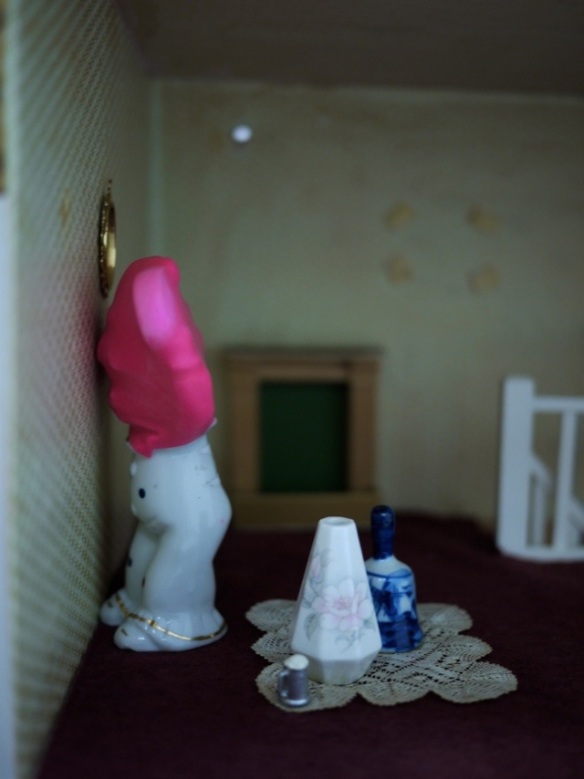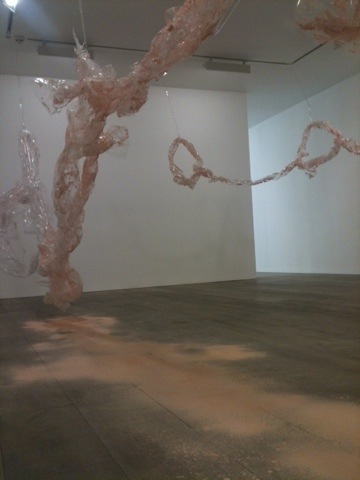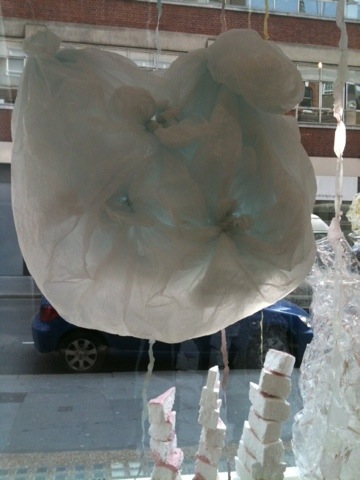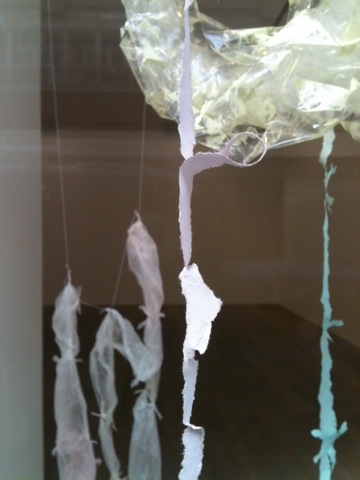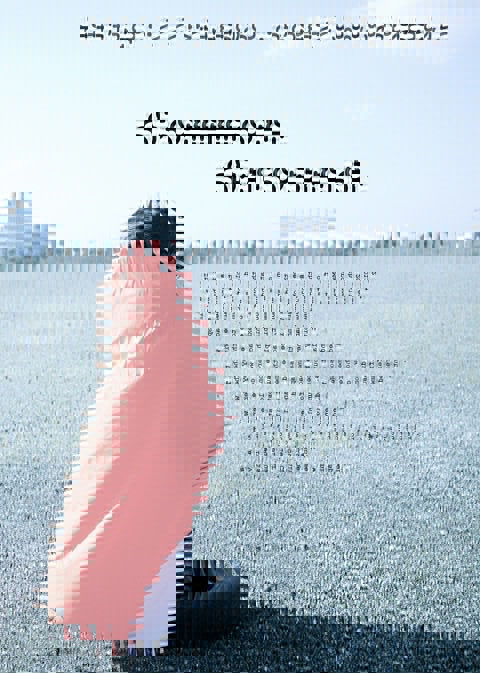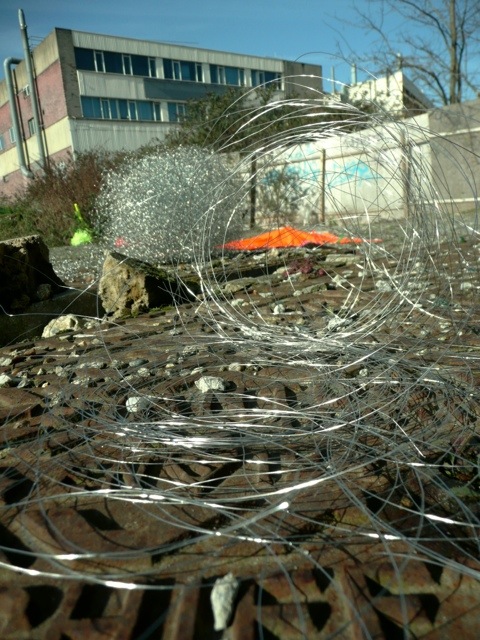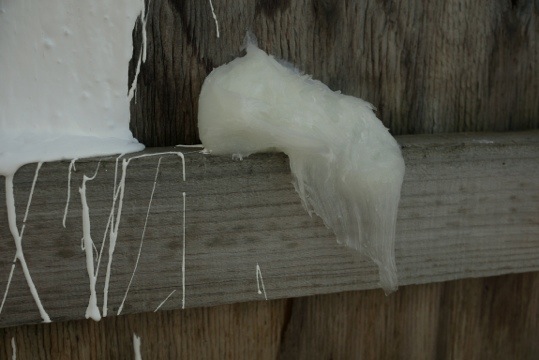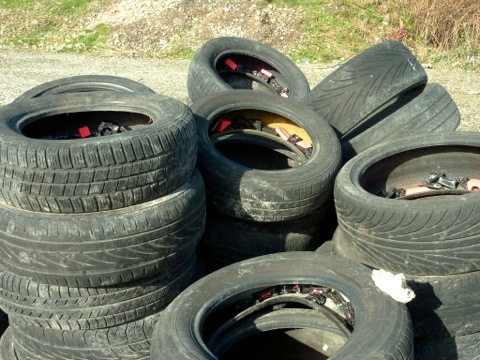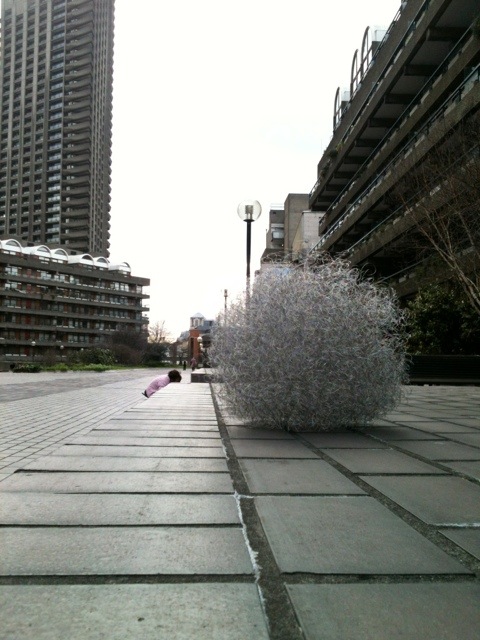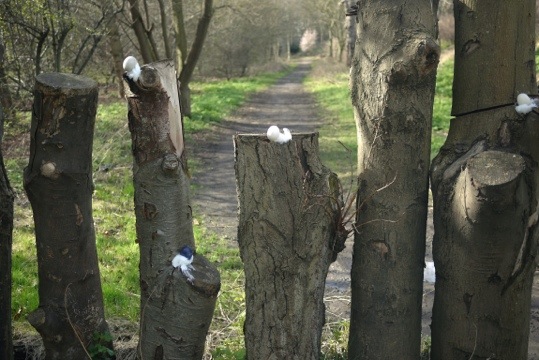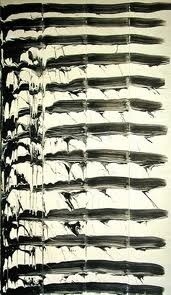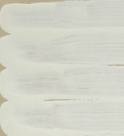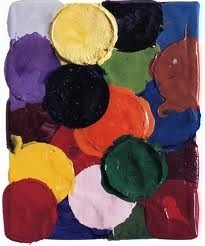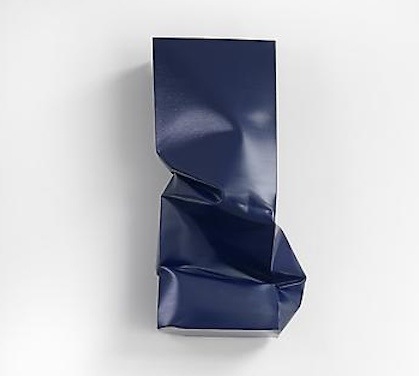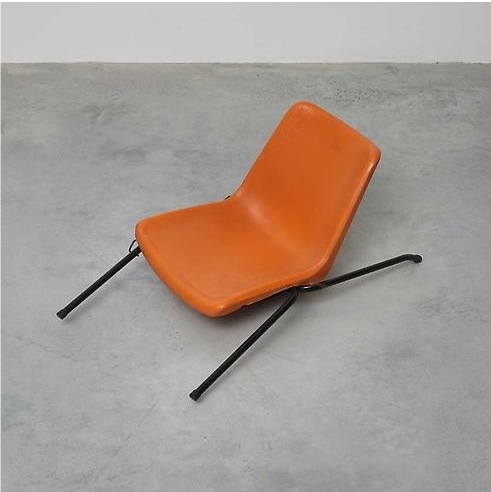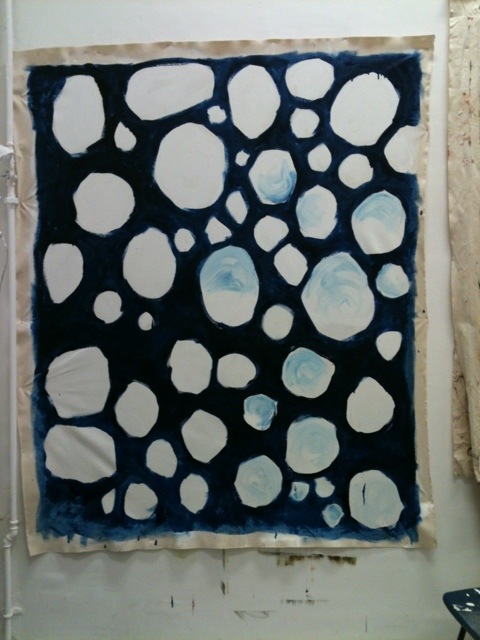Did some collaborative work this week, (to motivate Sarah into using the resources, and to distract me from making decisions…) It was seriously fun and stimulating combining our styles, our viewpoints, and bouncing off each other. Because the dolls house was borrowed, we couldn’t drip any paint or Vaseline, which was disappointing, but this is my favourite image…..
Karla Black @ Modern Art
Walking into the gallery space, I took with me a wariness created by some reviews which were not impressed by the show. However, I was also conscious of how much I had read and heard Karla speak, and was certain a treat would be waiting for me.
The first impression was the enormous weightiness of presence these ephemeral creations demand. Light, airy and floating, yet massively present. It was such a fabulous surprise to see how the ethereal sculptures held their ground, dominating the space and calling your attention to their self contained existence.
How they existed in the space was impressive. In the light of thinking about the gallery space in our term 2 exhibitions, I have been reading around the ideas of the gallery, particularly on the ‘frailty’ of painting that it needs to be ‘protected’ behind glass, kept safe in a frame, hidden behind bars, cordoned off and guarded by gallery assistants. To arrive in a white room with all these thoughts, it was wonderful to be able to engage with the sculpture, not cordoned off, nor protected, but to be able to walk in, around and through the work freely. As I moved through, the work gently swayed as my presence registered with the air’s movements. I sat on the floor, and spent time with it, looking up into the space. It took a while before I felt able to walk in to the centre of this sculpture, but when I did, it gave a strange sensation of the sculpture allowing me to be embraced by it, encompassing and surrounding me. It allowed me to see inside it, a generous invitation.

It held the space, it held the floor, it rewarded me more and more the longer I spent with it. A few visitors looked and walked on, leaving well before the pieces had a chance to speak. The longer I sat, and walked around and within, the more deeply I was enchanted. The quiet strength of this ethereal work resided in the space.
After a while, the personification of the work seemed to possess me. In the first room, all the sculptures were installed in the window spaces, leaving the rest of the room vacant. My mind began creating stories of these sculptures clamouring for attention, to be looked at, wanting to be seen and known by passers by. They seemed to be rejecting the vast luxurious space behind them in favour of being known, of being seen. But perhaps I’m just loosing my marbles?!?
How important was the white room? It seemed these pieces had made such a comfortable home in this space, am I to admit a white cube is what some work needs? Nah! I imagined taking these works into Hackney Marshes, or the Barbican, or Silvertown, and they would surely have found their home there. The work has strength in its materiality, courage in its assertion and so many spaces (including a white cube) could be its place of rest.
After Phyllida Barlow’s lecture at the Tate, I wondered if there were any verbs ‘contained’ in this work. Unlike Phyllida’s chop, slice, squeeze, push verbs, the ones that came to mind were drape, float, tie (bind seemed to fit in my mind, but my sense would not allow it, feeling too strong). In an interview for the Telegraph, Karla says, “They don’t point outside of themselves through language to metaphor and symbolism. They don have meanings in that narrative or autobiographical way, everything about them is held within them. they are physical realities in themselves. So instead of asking what is the meaning of these sculptures, I would ask what are the consequences of these sculptures, they actually do something in the world themselves and the consequences of this sculpture is that it forces a very raw creative difficult chaotic moment into an institutional situation. ” (www.telegraph.co.uk/culture/art/turnerprize…)
The final work
Reflecting on the day of collaborative work “Common Ground”
Reflections on day of filming for the exhibition as follows….
Yesterday, all 5 of us went ‘on location’ to film for the exhibition. We began in Silvertown in a disused, industrial space, went on to Hackney Marshes, then ended at the Barbican outside space. The whole day has left me buzzing, from creating spontaneous works in response to the surroundings, to collaborating in a joint venture with other artists who I respect and admire, and of course, the anticipation of the final film.
Here, mid process, post filming, pre editing, are a few reflections.
It was interesting to see how the five artists approached the task of the day. Sarah and I went with a selection of materials, to create a response to the space in the space with the pieces we had brought. Sarah said she literally wanted to ‘paint in the space’, with the objects and materials she had brought. My intention was to create a ‘material intervention’ in the space, responding to the space. Anwar and Bori took pieces of sculptural work with them, and installed them in response to the space. Bao Bao literally drank in the work and surroundings in the first two spaces, ready to record her work in the third setting. The most stunning thing of all (for me, it was literally shocking!) was the way the work worked together. The links were not forced, but natural and evolving. The relationship between the works spoke itself without needing to be manipulated. The comments and suggestions that flew across the spaces were in tune. It was a joy to collaborate, and there was no feeling of forced compromise.
The travel between sites was interesting as I had expected more collaborative talk. However, because the work was responsive, quite intuitive and fairly spontaneous, the chat between sites was reflective on what had been done (mostly enjoying each others work), and talk about method (we must be quicker at the next site/leave no permanent imprint/ avoid getting arrested etc).
On a personal note, I was surprised at what I achieved. I was pleased to find myself making different work in each site. I had some thoughts before I left, some possibilities which I thought I might rework in each sight. It delighted me to find that through working with others and prioritising responding to the space, each work came out differently, yet marvellously connected. I used some objects from the spaces (a discarded tin, a cement brick) to relate to the objects and materials I had brought. That was a spontaneous decision, but I found it really worked alongside the intentions I had.
Through the day, it became clear to me that the live action of materials, the wetness, sliminess, dripping, falling and human impression on the materials were was brought greatest joy in my work. The thick, gloupy paint spilling over the materials, and even the gentle movement of wind across the watery pool. These physical movements situated alongside the forms of the shards of solid paint, the eggs of various solid, dense materials. The forms themselves, the beautiful curve around the cement cast egg, the resistance of water on the wax egg, the organic invasion of my materials into their surroundings was simply thrilling.
Seminar group feed back on our exhibition
The response to the work was incredibly positive, which was brilliant having put so much work into it, but for once, I was not surprised as I had a strong conviction of the work’s strength.
Here are the comments made, in the order they were made, following the train of the conversation.
There is a strong sense of continuity through the work, exciting to see such apparent collaboration
Strong sense of itinerant, potential movement, need to move. Particularly interesting with relation to yesterday’s exhibition, Spare Room
At first there was a sense of trying to recognise whose work was whose, but quickly disappeared, as the film took over.
There were points indicating change, pace, surprises, kept guessing.
Is the film a work in its own right or documentation? Overwhelming view of the latter. What has been created is a completely new art work.
The experience of being there translates through the music work.
Focus was acute, taught and intense. Spaces that were vast were brought into tight focus, pinpoint, exclusive
Feels intimate, yet space. Like viewer is there with the pieces.
Is it controlling? Viewer sees what you want them to see.
If we had actually been there, we would have had a very different experience, we would have looked at end existed in the whole space, differently. Therefore more than documentation.
Reminded of French film “tell no one”
Shift around 2/3 through, became clear looking at someone’s art work, camera placing the art centre stage, was on the cusp of being jarring or being interesting. A protagonist, camera looking direct.y, it was undeniably someone’s work. Partly troubling, partly upped a gear. Altered response.
Responding differently in each space, a sense of going places, constantly shifting.
The tone was sad, poignant, oil based materials, reference to what has been before (industrial history of silvertown). Yet not in a morbid way.
Interesting to note how the weather would affect the work.
Delicate intervention, not too much.
Whitechapel artist (Serena??) considering in relation to that work. Overly aesthetic? Slightly undermined by the beauty, but our work seems less concerned with that, perhaps more ‘truthful’. Possibility of freedom from aesthetic concerns as intention was to document an event, not deliberately create a film.
A sense of documentation of something we’ve missed, that the filming is an event that has been missed by the viewer. Already existed without me.
A peep into your world. A slice of magic.
Discussions around the role of the voyeur/ viewer. Hostile? Controlled? Left behind?
Sense of reminiscing, melancholic, but not completely. Another quality preventing it being melancholic.
Real sense of collaboration.
Distortion, jarring, not feeling too comfortable.
Common Ground- collaborative work, shared responsibility, finding it, a sense of displacement, looking back, of movement.
Seeing the spaces through the eyes of the objects.
Small, close, invite to look closely.
Feeling of immigration, being from another place, trees, texture, floor, sky.
The yellow fabric on the floor, holding on for dear life, of something that is a part of itself.
Scale
My work is small, I know that, but is it important? Is it necessary to be small? I became very conscious of it today, returning from Angela De La Cruz’s studio. Monumental work in a tiny space. Mine, tiny work in a tiny space, yet a large room. It’s something I’ve considered before. in the triangle space my work was positively dwarf. Yet is that important? Of the various ceramic humps I have made, the large one has been the most difficult to work with. The least successful. of the various tHings I have tried, the larger scale has just not cut the mustard.
So, is there a different approach. One observer today commented that perhaps mt work is significantly small, hand held, resulting in the viewer becoming monumental. I need to sit with that a while. I like the sound of it, something rings true.
The Indiscipline of Painting
To say this show took my breath away is no understatement. After a long journey, knowing the Bernard Frize talk was cancelled, we arrived and had a coffee to give us some strength. But we didn’t need it. As we walked into the first room, I was hit with ryman’s….. And ….. Two amazing paintings where paint was the hero. Without exception, this show had work that celebrated and honoured the very medium of paint, it’s liquidity, it’s ability to delineate movement, it’s ability to be celebrated for what it is.
To choose a favourite in each area (a silly game I play, making myself explain why…) was SO difficult. The potential and variety of the work and the possibilities each one suggested was awe inspiring. Thankfully I was going around the show with Georgina, which made us both stop and question where the source of interest lie in that which arrested us. Made made some pretty impressive guesses around the creation and nature of some of the works, clarified by Daniel Sturgis later.
The curation of the show was interesting too- from each section, you received glimpses of paintings you had not yet seen, and ones you had been past. The potential conversations between the works were so interesting.
The questions after with Daniel Sturgis proved informative, hearing his reasons for choosing the works, and more details about the ones that puzzled me. My favourite of his answers was in response to a question about the monochrome work. …. He simply said “People say abstract artists have no skill. I disagree. And this is evidence enough.”
The crossing between disciplines of abstract painting was the key idea behind the show, how painting ‘borrows’ from design, popular culture, architecture and the like. For me that had limited interest. The action of paint on surface, the artists presence and action was soul food. To see such variety of approaches and results where the paint was celebrated, both through modernism and in contemporary work was inspiration, to say the least.
Back at the painting seminar, interestingly someone else who had been at the show said “this wasn’t the kind of work you could look at for long. A bit of a one hit wonder”. As I considered her remark with bewilderment, I again realised just how significant this show has been for my work. Materiality all the way!!
Angela De La Cruz studio visit
At the eleventh hour, I received a text, someone had cancelled, so did I want to come.
Breathtaking.
Angela’s studio in my mind would be large, airy, clean and with vast roominess. Instead, two small rooms are where she and her two assistants work. The space may be limited, but the work is certainly not.
In the two rooms we saw ‘Bloated’ an new series of works for an up coming Biennial. What a privilege. The forms take on the bodily proportions of angela, height and breadth, boxed almost coffin like in aluminium, beaten from inside until splitting, almost broken apart. They are made slowly and precisely according to Angela’s exacting instructions, and regularly scrutinised the returned for remaking. She keeps a close eye, watching, scrutinising,checking. Her assistant Will saw no threat in this, just the need for her to create precisely her own work. He described her work as enormously personal, her measurements, her feelings, her transforming since the stroke.
Her work bears weighty titles, such as Bloated, Deflated, Homeless, Scratch, Submerged and Flat. Her subjects are weighty too, often herself, her own ongoing recovery, but also as she talked, she referred to films (Misery), the tsunami, Bill Clinton and bodies of soldiers in Iraq. Her meaning is achieved simply and poetically, with a singularity of intention. Her works stand authoritatively, where the meanings are deeply imbued in the work, but not dominantly controlling them.
When asked, Angela declared all her work painting.
As she described the making of ‘Compressed’ the repeated beating of an aluminium box of exactly Angela’s measurements from above with a fork lift truck. Each work bends and buckles in a unique way, even though they all sustain the same attack, the response is unique, and resulting in luxurious distortions and buckles in its materiality. It is beaten until it reaches the height of Angela in her wheelchair. Beautiful and tragic. Yet she makes clear she does not want pity.
Pity? No, I think the only appropriate response is an enormous dose of respect.
Hockney At the RA
He expressly and clearly declares his love of image making, so Hockney and I were not the best of bed fellows. However, a kind friend bought me a ticket, I had watched the documentary screening at the graduate school (the person being significantly more interesting than the work), so it seemed foolish to snub.
The breadth of the exhibition was pretty vast (would a college lecture have suggested more editing??!) and the colour feast rich. I was most excited in two rooms, the earlier works (including pearl blossom highway) and some interesting works not from observation, but from imagination.
Imagination is where I felt the greatest interest lay. Where Hockney allows his imagination and memory to collide, a more interesting image arrives (according to my own, humble opinion). The trees become blue, and curling into tunnels, the pathways and shadows vibrantly alive, the hawthorn blossom almost alive and squirming. These gave much deeper food for my imagination and sensory awareness, and gave me a fresh view. The observational works gave the fuel for these far more interesting canvases.
The widely reputed iPad drawings disappointed me. Points for embracing technology, the speed of recording impressive, but did they warrant a whole room? Many old ladies commented loudly in the room about the number chosen, and the editing process crossed my mind again. However, their benefit was the resulting joy of coming across paint on canvas again, a welcome material relief from the synthetic and flat iPad print outs.
Finally,I came across the best room of the exhibition- the video work. 9 cameras from fixed viewpoints, an exercise in ‘concentrated looking’. The journey along the roads were interesting, but the scenes inside his studio, with dancers and vibrant colour, again, prompted me to think again, imagine and consider freshly. That’s what I love in art. Something that pushes my mind and e, my memory and imagination.
Exploring materiality
Being in college today was like one of those refreshing walks on the beach, sea breeze reaching places not refreshed in a while. I boldly returned to paint on canvas. Having spent the last weeks of term exploring materiality in various materials, paint kept showing itself as the material of preference. Even stunning materials like wax and Vaseline cried to have paint combined with them. So today, I took my first step exploring paint on a surface, looking to apply all the playfulness of the sculptural work, but with paint alone.
The first thing I noticed was how easily lost I was in freely applying the paint to canvas, with no desire to be precious. The aroma and feel of paint dripping from the brush, travelling across the surface of the canvas and crying out to bE reloaded was a sensory delight. The joy of working with the material was wonderful.
The second thing I noticed was my lack of desire for a finished painting (hurrah!). This activity was purely about materiality, and so the anticipation of the layers and colours that will be added spurred me on instead of trying to complete an image (hurrah again!). My desire was all around Letting the paint do the work, to react and respond to what it offers.
So for these reasons it deserves a blog post of its own. A day of lessons applied.
And I quite like the forms too…….

